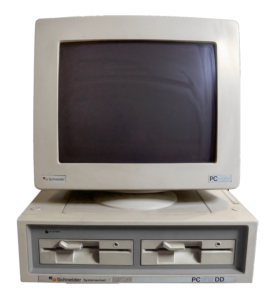A former student of mine contacted me out of the blue recently. She wanted to interview me about the use of computers in education.
She asked: Have computers made a big difference in schools in your experience?
You bet they have!
My first computer
I bought my first computer early in 1991. I can still remember the excitement. The packaging and the thick brick of the manual. The look and the touch of the matt-cream plastic box. The black glass screen that lit up with white letters that burned across when I switched it on: BOOTING UP…
It had no internal memory. When you switched it on it had to start – boot – by first reading the operating system from two 3 inch floppy discs which each held 512 kilobytes of information. (For anyone who remembers, 3½ inch discs were the industry standard. My computer’s discs were incompatible with any other computer I ever came across.)
At the time, we lived in Sundsvall. The snows of winter lay piled around outside and the reflected light from the snow lit the ceiling of the room where the computer stood. That light still has the capacity to raise my heart and is forever linked in my mind with the smell of warm plastic and that first Amstrad.
Amstrad

The Amstrad was the first home computer in Britain. Produced and sold by Alan M. Sugar Trading. Alan Sugar is nowadays “famous from TV” as the entrepreneur in the British version of The Apprentice. I was probably one of the few people to import an Amstrad to Sweden. Not the only one I know for a fact, but one of just a few. (For the nerds my computer was an Amstrad PC1512-SD with a mono screen.)
I bought it principally as a word processor to replace my typewriter, which I kept “in case”. At first the typewriter stood handy on a shelf in the same room as the computer. Later it was stored at the back of a cupboard. Later still it stood in the basement. It followed me for two moves and from Sundsvall to Gothenburg – and actually outlasted the Amstrad – but I never used it again.
Hoarder that I am, I still have stories, business letters and teaching material that I prepared on the Amstrad. They were printed in NLQ. (“Near Letter Quality” – it was Amstrad’s own proud and, now I look at it, quite meaningless term). I printed them on the accompanying dot-matrix printer that sounded like a mad snare drummer on speed. The relief when I could move to a much quieter ink-jet.
Computers at school
We didn’t get computers at school until about three years later, and though we teachers were sharing PCs in our offices there was initially only one computer room for the students. The computer room was the domain of the maths department. Oh, the turf wars over whether students should be allowed computer time to write their reports for other subjects. Grudgingly, grudgingly they were allowed to print out from floppy discs brought from home – those who had home computers. Until the first virus was brought in and corrupted the system.
Fast forward to 2007 and the set of laptops computers we had available for one language class at the school where I was then working. Or 2014 and the distance teaching I am currently involved with, holding classes in virtual conference rooms, my students sitting in their homes or offices and joining in from all across Sweden and, potentially, the world.
Yes, in my experience computers have made a big difference in schools.
But, there’s more.
Tactile aids
I trained to be a teacher back in England, in Birmingham, in 1981. My focus and long essay subject: “the use of audio, visual and tactile aids in the teaching of history”. Never mind the other weird and wonderful things I got to play with for that (think tactile and let your imagination run wild), it also gave me entry to the computer room at Handsworth Grammar School. There, the maths teacher (who would probably not otherwise have given me – a non-scientist – the time of day) was delighted to show off his pride.
The school’s computer was a second-hand gift from a local engineering firm. The pupils spent their maths lessons punching holes into cards that they fed into the computer in order to get it to solve mathematical equations. I still have no concept of the value of this exercise, but everyone in the class seemed very dedicated and busy.
My interviewer coughed politely at this point and said: What do you mean by “they punched holes into cards”?

This article was written for the #Blogg52 challenge. The photograph of an Amstrad computer that isn’t quite the same as the one I owned comes from Wikimedia Commons.
I originally published this article on the separate At the Quill website. I revised it for spelling and carried out some SEO fine-tuning – and added a featured image – before transferring it here on 30 March 2017.


Känner igen allt det du berättar om. Har också varit med om datorns födelse, om hålremsor och följt datorns utveckling allt ifrån blysättningens tid. Ett härligt inlägg.
Kram Kim 🙂